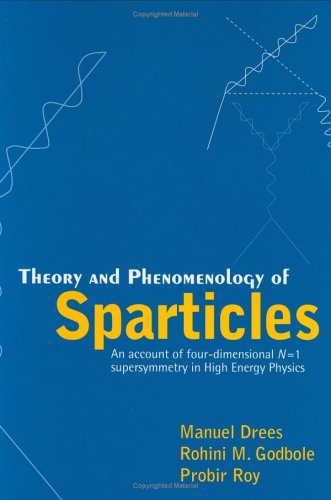

Most ebook files are in PDF format, so you can easily read them using various software such as Foxit Reader or directly on the Google Chrome browser.
Some ebook files are released by publishers in other formats such as .awz, .mobi, .epub, .fb2, etc. You may need to install specific software to read these formats on mobile/PC, such as Calibre.
Please read the tutorial at this link. https://ebooknice.com/page/post?id=faq
We offer FREE conversion to the popular formats you request; however, this may take some time. Therefore, right after payment, please email us, and we will try to provide the service as quickly as possible.
For some exceptional file formats or broken links (if any), please refrain from opening any disputes. Instead, email us first, and we will try to assist within a maximum of 6 hours.
EbookNice Team

Status:
Available5.0
23 reviews(Ebook) Theory and Phenomenology of Sparticles 1st Edition by Manuel Drees, Rohini Godbole, Probir Roy - Ebook PDF Instant Download/Delivery: 9789810237394 ,9810237391
Full download (Ebook) Theory and Phenomenology of Sparticles 1st Edition after payment

Product details:
ISBN 10: 9810237391
ISBN 13: 9789810237394
Author: Manuel Drees, Rohini Godbole, Probir Roy
(Ebook) Theory and Phenomenology of Sparticles 1st Edition Table of contents:
Chapter 1. Supersymmetry: Why and How
1.1 History and motivation
1.2 Quadratic divergence and unnaturalness
1.3 Naturalness nonrenormalization supersymmetry
References
PART ONE SUPERSYMMETRY FORMALISM
Chapter 2. Preliminaries
2.1 Grassmann elements and variables
2.2 Supersymmetric harmonic oscillator
2.3 Glimpse of superspace
2.4 Supersymmetry and spacetime transformations
References
Chapter 3. Algebraic Aspects
3.1 Supersymmetry algebra
3.2 Two component notation
3.3 Particle supermultiplets
References
Chapter 4. Free Superfields in Superspace
4.1 General superfield in superspace
4.2 Chiral covariant derivatives
4.3 Left and right chiral superfields
4.4 Vector superfields
4.5 Matter parity and R-parity
References
Chapter 5. Interacting Superfields
5.1 System of interacting chiral superfields
5.2 Abelian gauge interactions
5.3 Supersymmetric quantum electrodynamics (SQED)
5.4 Nonabelian gauge interactions
5.5 Supersymmetric quantum chromodynamics (SQCD)
5.6 Supersymmetric chiral gauge theory (SxGT)
References
Chapter 6. Superspace Perturbation Theory and Supergraphs
6.1 Nonrenormalization of superpotential terms
6.2 Functional methods in superspace
6.3 Functional formulation of superfield theory
6.4 GRS Feynman rules for the Wess-Zumino model
6.5 Feynman rules for non-abelian supergauge theories
6.6 Sample one loop supergraph calculations
6.7 The nonrenormalization theorem
6.8 One loop infinities and B-y-functions
6.9 Renormalization group evolution
References
Chapter 7. General Aspects of Supersymmetry Breaking
7.1 Initial remarks
7.2 Spontaneous supersymmetry breaking: some generalities
7.3 The goldstino
7.4 Model of F-type supersymmetry breaking
7.5 Model of D-type supersymmetry breaking
7.6 Dynamical model of supersymmetry breaking
7.7 Soft explicit supersymmetry breaking
7.8 The general mass sum rule
References
PART TWO SUPER SYMMETRY PHENOMENOLOGY
Chapter 8. Basic Structure of the MSSM
8.1 Brief review of the Standard Model
8.2 Superfields of the MSSM
8.3 Supersymmetric part of the MSSM
8.4 Some non-Higgs vertices of the MSSM
References
Chapter 9. Soft Supersymmetry Breaking in the MSSM
9.1 The content of LSOFT
9.2 Electroweak gauginos and higgsinos
9.3 Chargino and neutralino interactions with gauge bosons
9.4 Masses and mixing patterns of sfermions
9.5 The Flavor problem in supersymmetry
9.6 Interactions of sfermions with gauge bosons
9.7 Fermion-sfermion-gaugino/higgsino interactions
9.8 Quartic sfermion vertices
References
Chapter 10. Higgs Bosons in the MSSM
10.1 Higgs potential in the MSSM
10.2 Spontaneous symmetry breakdown and VEVs
10.3 Higgs masses at the tree level
10.4 Higgs-particle vertices
10.5 Higgs-sparticle vertices
10.6 Radiative effects on MSSM Higgs particles
References
Chapter 11. Evolution from Very High Energies
11.1 The need for a high scale
11.2 The running of gauge couplings in the SM and the MSSM
11.3 Derivation of the remaining RGE equations
11.4 Application to the MSSM
References
Chapter 12. Gravity Mediated Supersymmetry Breaking
12.1 General remarks
12.2 N=1 supergravity broken in the hidden sector
12.3 mSUGRA and its parameters
12.4 Phenomenology with mSUGRA
12.5 Beyond mSUGRA
12.6 Quantum effects and extra dimensions
12.7 Annex to Chapter 12: A brief introduction to N=1 supergravity
References
Chapter 13. Gauge Mediated Supersymmetry Breaking
13.1 The basic ingredients
13.2 The minimal model mGMSB
13.3 Nonminimal messenger sector
13.4 The u and Bu problems
13.5 Direct messenger-matter couplings
13.6 Flavor symmetries for the GMSB scenario
References
Chapter 14. Beyond the MSSM
14.1 Motivation and outline
14.2 The next-to-the-minimal supersymmetric standard model
14.3 Introduction to R-parity violation
14.4 Phenomenological limits on trilinear Rp couplings
14.5 Bilinear Rp violation
14.6 Neutrino masses in supersymmetric theories
References
Chapter 15. Supersymmetry at Colliders
15.1 Introduction
15.2 Signals of charginos and neutralinos
15.3 Signals of sleptons
15.4 Signals of gluinos and squarks
15.5 The quest for supersymmetric Higgs bosons
15.6 Collider signals in the presence of Rp violation
References
Chapter 16. Supersymmetric Cosmology
16.1 Introductory remarks
16.2 Standard Big Bang cosmology
16.3 Dark matter as a supersymmetric BB relic
16.4 Cosmology of the gravitino
16.5 Baryogenesis
References
Chapter 17. Conclusion: Wish List Road map and Fine Tuning
References
Appendix A: Sparticle Vertices in the MSSM
Appendix B: Higgs Vertices in the MSSM
Bibliography
Index
People also search for (Ebook) Theory and Phenomenology of Sparticles 1st Edition:
zizek phenomenology of spirit
z@p phenomenology
theory of space and time
the phenomenology of the spirit
experimental phenomenology
Tags: Manuel Drees, Rohini Godbole, Probir Roy, Phenomenology, Sparticles